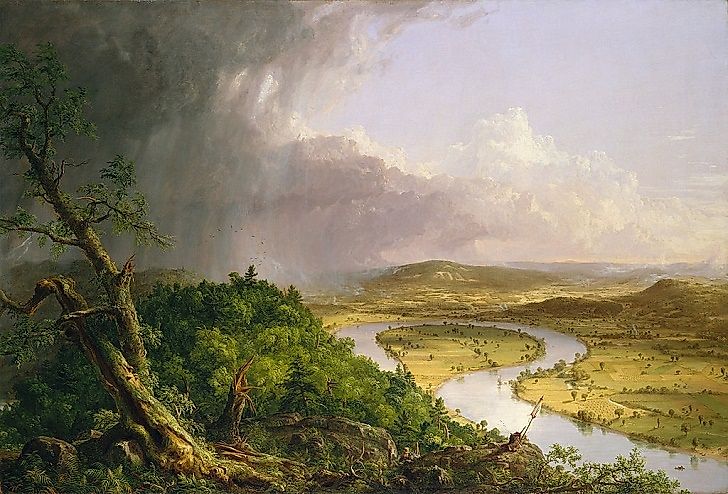What Was The Hudson River School Art Movement?

The art movement was particularly influential on landscape painters in the northeastern United States in the 1800s. The name “Hudson River School” applied retrospectively as a similarity of intent rather than a geographical location. Most of the inspiration came from the Catskill Region of New York that provided grandiose scenes of the valley through which the Hudson River flows through. The movement was strongly nationalistic and proudly celebrated American Landscape beauty as a manifestation of God. Throughout the 19th Century, the movement grew and developed as their work popularized around the world. Hudson River School became American First School of Art.
5. Overview and Characteristics -
The Hudson River School was an American art movement in the mid-19th Century revolving around a group of landscape painters influenced by romanticism. The paintings of the art movement reflect three American themes that existed at the time settlement, exploration, and discovery. The paintings elaborate on the pastoral setting of the American landscape as a country where human beings and nature coexist peacefully. The Hudson River School Art Movement was a complete manifestation of the group belief that America is the exact manifestation of God. Their work reflects their devotion and conviction to God. The paintings were characterized by their detailed, realistic and idealized portrayal of nature in which the Hudson Valley diminishes as Agriculture flourishes. The artists traveled far and wide looking for unusual and extreme environments where they recorded sketches and memories and finished the real work in the studio.
4. Origins -
There is no certainty in regards to the origins of, or who conjured up, the term “the Hudson River School”, but it is thought to have originated from Clarence Cook’s New York Tribune or Home Dodge Martin, a landscape painter. Thomas Cole, famed as the founder of the Hudson River School, arrived in Hudson Valley in 1825. His first landscape paintings were of the Catskill Mountains of New York State. He found the regional panorama inspirational and together with Asher Durand, they formed the first generation of Hudson River Valley. After the American Revolution in 1812, nationalism provided ground for appreciating nature. Arguing that even though America lacked the cultural heritage of Europe in that it lacked the Mona Lisa, Shakespeare, Gothic Cathedrals, and Parthenon, the young country had a vast landscape where sublime encounters with the divine happened. This culture first spread among the elite urban centers diffusing to all places by the late 18th Century. The Hudson River School origins date back to these romantic and nationalism ages of America.
3. Spread and Development -
From the onset, Cole’s artistic styles and unique ways of capturing nature on a piece of paper marked dramatic and vigorous techniques in painting that reflected the British aesthetic theory of a noble and fearsome nature. His work on the infant American landscapes of the early 19th Century was accorded with growing appreciation not addressed before. The Wilderness themes gained currency in the American Literature such as in the Leatherstocking novels of James F. Cooper set in upstate New York. Cole painted pictures as depicted by the novelist. Cole toured the European countries, and at times he translated Italian landscapes into paintings. The school continued to gain popularity across the group as more work from their paintings was published. In 1850 Durand wrote “Letters on Landscape paintings” a magnificent capture of a new generation painter themes and in a way pushed Cole’s subjects and style to the past. Durand work gained popularity especially the outdoor sketching in oils as a foundation of studio landscapes and features of light themed physical forms. His paintings captured the light, and the tranquility found only in America. His ideas spread far and wide especially as tourist resorts proliferation both inland and the coastal areas during the Civil War period and the newly refined vacation experience meant to relieve the pressure of the urban workers. Bierstadt later adopted a course somewhere between Cole and Durand. Church inspired by the experience and writings of the German naturalist Alexander von Humboldt replaced Cole’s scientific and spiritual concerns involved in his historical paintings. Albert Bierstadt painted mountain landscapes on enormous canvases which included pictures of wild scenery filled with mists and clouds.
2. Notable Practitioners -
The most prominent practitioners include the founder of the movement, Thomas Cole, along with Thomas Doughty and the well-known Asher Durand, who painted pictures of the untouched wilderness areas of the Hudson River Valley and New England. Other notable practitioners committed to displaying the beautiful landscapes of Northeastern US were Henry Inman, Alvan Fisher, and Samuel F.B. George Inness, a famous painter, started out as a Hudson River artist. Frederic Edwin Church, famous for his exotic and dramatic landscape paintings is also a key member of the movement. Others included John Kensett, Worthington Whittredge, Jasper F. Cropsey, and John Casilear. For painters who themed on untouched landscapes, the West provided primitive and dramatic scenes where Henry Lewis and John Banvard who painted Huge Panoramas of empty stretches of Mississippi River. Artists who explored the far west included Thomas Moran and Albert Bierstadt. They painted the Rocky Mountains, Yosemite Valley, and Grand Canyon.
1. Greater Significance and Legacy -
The Hudson River School was so influential because it was the first true artistic fraternity for the young American nation. The movement brought independence to American-born artists who depended on European art schools. For more than 50 years, the romantic and awe-inspiring paintings of the movement captured the image of the American East Coast and the Wild West whose inhabitants had little experiences or photographs of the wilderness of America. The Hudson River School spawned several other painting styles, including Luminism and the Rocky Mountain School. The school shared the belief that America was the true manifestation of God.











